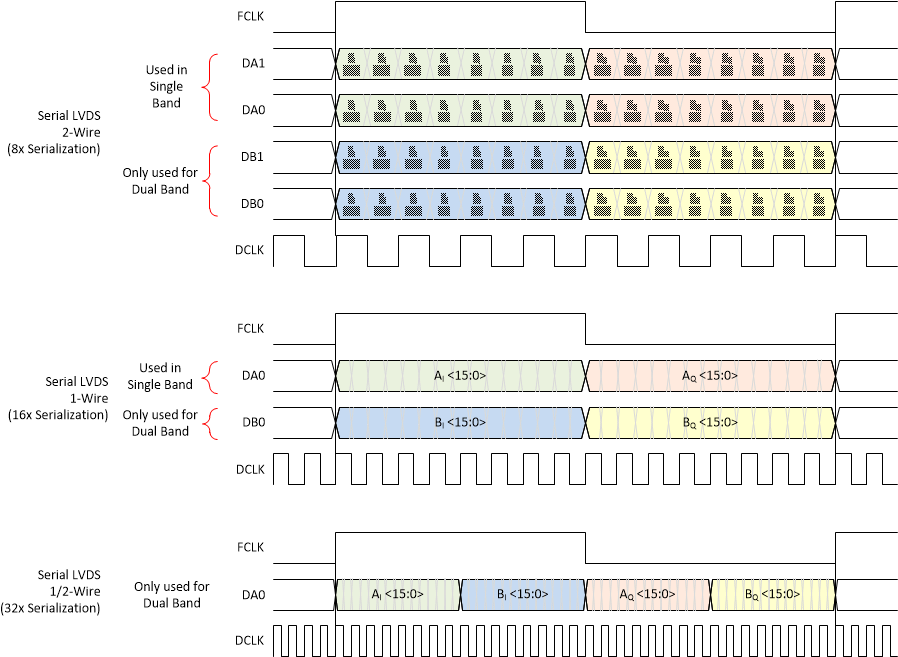SBAS990B February 2021 – October 2022 ADC3561 , ADC3562 , ADC3563
PRODUCTION DATA
- 1 Features
- 2 Applications
- 3 Description
- 4 Revision History
- 5 Pin Configuration and Functions
-
6 Specifications
- 6.1 Absolute Maximum Ratings
- 6.2 ESD Ratings
- 6.3 Recommended Operating Conditions
- 6.4 Thermal Information
- 6.5 Electrical Characteristics - Power Consumption
- 6.6 Electrical Characteristics - DC Specifications
- 6.7 Electrical Characteristics - AC Specifications
- 6.8 Timing Requirements
- 6.9 Typical Characteristics - ADC3561
- 6.10 Typical Characteristics - ADC3562
- 6.11 Typical Characteristics - ADC3563
- 7 Parameter Measurement Information
- 8 Detailed Description
- 9 Application Information Disclaimer
- 10Device and Documentation Support
- 11Mechanical, Packaging, and Orderable Information
Package Options
Mechanical Data (Package|Pins)
- RSB|40
Thermal pad, mechanical data (Package|Pins)
- RSB|40
Orderable Information
8.3.4.7 Output Formatting with Decimation
When using decimation, the output data is formatted as shown in Figure 8-39 (complex decimation) and Figure 8-40 (real decimation).
 Figure 8-39 Output Data Format in Complex Decimation
Figure 8-39 Output Data Format in Complex DecimationTable 8-4 illustrates the output interface data rate along with the corresponding DCLK/DCLKIN and FCLK frequencies based on output resolution (R), number of SLVDS lanes (L) and complex decimation setting (N).
Furthermore the table shows an actual lane rate example for the 2-, 1- and 1/2-wire interface, 16-bit output resolution and complex decimation by 4.
| DECIMATION SETTING | ADC SAMPLING RATE | OUTPUT RESOLUTION | # of WIRES | FCLK | DCLKIN, DCLK | DA/B0,1 |
|---|---|---|---|---|---|---|
| N | FS | R | L | FS / N | [DA/B0,1] / 2 | FS x 2 x R / L / N |
| 4 | 65 MSPS | 16 | 2 | 16.25 MHz | 130 MHz | 260 MHz |
| 1 | 260 MHz | 520 MHz | ||||
| 62.5 MSPS | 1/2 | 15.625 MHz | 500 MHz | 1000 MHz |
 Figure 8-40 Output Data Format in Real Decimation
Figure 8-40 Output Data Format in Real DecimationTable 8-5 illustrates the output interface data rate along with the corresponding DCLK/DCLKIN and FCLK frequencies based on output resolution (R), number of SLVDS lanes (L) and real decimation setting (M).
Furthermore the table shows an actual lane rate example for the 2-, 1- and 1/2-wire interface, 16-bit output resolution and real decimation by 4.
| DECIMATION SETTING | ADC SAMPLING RATE | OUTPUT RESOLUTION | # of WIRES | FCLK | DCLKIN, DCLK | DA/B0,1 |
|---|---|---|---|---|---|---|
| M | FS | R | L | FS / M / 2 (L = 2) FS / M (L = 1, 1/2) | [DA/B0,1] / 2 | FS x R / L / M |
| 4 | 65 MSPS | 16 | 2 | 8.125 MHz | 65 MHz | 130 MHz |
| 1 | 16.25 MHz | 130 MHz | 260 MHz |